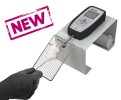Authors
J. J. Luszczki, R. Czernecki, K. Wojtal, K. K. Borowicz, S. J. Czuczwar.
Lab
Medical University, Department of Pathophysiology, and Institute of Agricultural Medicine, Department of Physiopathology, Lublin, Poland.
Journal
Journal of Neural Transmission
Abstract
Accumulating evidence indicates that agmatine (AGM—an endogenous neuromodulator/neurotransmitter in the brain) exerts the anticonvulsant action in various in vivo experiments. Therefore, the aim of this study was to assess the influence of AGM on the protective action of numerous conventional and newer antiepileptic drugs [carbamazepine (CBZ), lamotrigine (LTG), oxcarbazepine (OXC), phenobarbital (PB), phenytoin (PHT), topiramate (TPM) and valproate (VPA)] in the mouse maximal electroshock seizure (MES) model. Results indicate that AGM (up to 100 mg/kg, i.p., 45 min before the test) neither altered the threshold for electroconvulsions nor protected the animals against MES-induced seizures in mice. Moreover, AGM (100 mg/kg, i.p.) significantly enhanced the anticonvulsant effects of PB and VPA in the MES test by reducing their ED50 values from 22.54 to 16.82 mg/kg (P < 0.01) for PB, and from 256.1 to 210.6 mg/kg (P < 0.05) for VPA, respectively. In contrast, AGM at 100 mg/kg (i.p.) had no significant effect on the antielectroshock action of the remaining drugs tested (CBZ, LTG, OXC, PHT, and TPM) in mice. Estimation of total brain PB and VPA concentrations revealed that the observed interactions between AGM and PB or VPA in the MES test were pharmacodynamic in nature because neither total brain PB, nor total brain VPA concentrations were altered after i.p. administration of AGM at 100 mg/kg. Moreover, none of the examined combinations of AGM (100 mg/kg) with CBZ, LTG, OXC, PB, PHT, TPM, and VPA (at their ED50 values from the MES test) affected motor coordination in the chimney test, long-term memory in the passive avoidance task, and muscular strength in the grip-strength test in mice, indicating no acute adverse effects in animals. In conclusion, one can ascertain that the selective potentiation of the antielectroshock action of PB and VPA by AGM, lack of any pharmacokinetic interactions between drugs and no acute adverse effects, make the combinations of AGM with PB or VPA of pivotal importance for epileptic patients. It seems that modulation of AGM concentration in the brain may occur favorable in further clinical practice.
BIOSEB Instruments Used:
Grip strength test (BIO-GS3)

 Douleur - Allodynie/Hyperalgésie Thermique
Douleur - Allodynie/Hyperalgésie Thermique Douleur - Spontanée - Déficit de Posture
Douleur - Spontanée - Déficit de Posture Douleur - Allodynie/Hyperalgésie Mécanique
Douleur - Allodynie/Hyperalgésie Mécanique Apprentissage/Mémoire - Attention - Addiction
Apprentissage/Mémoire - Attention - Addiction Physiologie & Recherche Respiratoire
Physiologie & Recherche Respiratoire
 Douleur
Douleur Métabolisme
Métabolisme Système moteur
Système moteur Neurodégénérescence
Neurodégénérescence Thématiques transversales
Thématiques transversales Système musculaire
Système musculaire Functions de motricité générale
Functions de motricité générale Troubles de l'humeur
Troubles de l'humeur Other disorders
Other disorders Joints
Joints Système Nerveux Central (SNC)
Système Nerveux Central (SNC)  Système sensoriel
Système sensoriel
